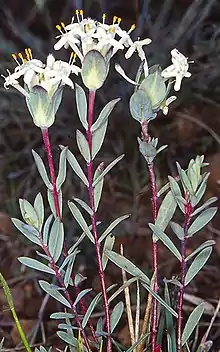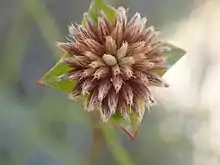| Pimelea glauca | |
|---|---|
 | |
| Flowers | |
| Scientific classification | |
| Kingdom: | Plantae |
| Clade: | Tracheophytes |
| Clade: | Angiosperms |
| Clade: | Eudicots |
| Clade: | Rosids |
| Order: | Malvales |
| Family: | Thymelaeaceae |
| Genus: | Pimelea |
| Species: | P. glauca |
| Binomial name | |
| Pimelea glauca | |

Pimelea glauca, commonly known as smooth riceflower,[2] is a species of flowering plant in the family Thymelaeaceae and is endemic to eastern Australia. It has elliptic to more or less lance-shaped or linear leaves and creamy-white flowers arranged in heads of seven or more on the ends of the stems, with four lance-shaped to egg-shaped bracts at the base of the inflorescence.
Description
Pimelea glauca is a much-branched shrub that typically grows to a height of up to 1 m (3 ft 3 in) and has glabrous stems. The leaves are narrowly elliptic to lance-shaped or linear, 3–15 mm (0.12–0.59 in) long and 1–6 mm (0.039–0.236 in) wide ending with a short, downward curving, sharp point. The inflorescence consists of 7 to 35 creamy-white tube-shaped flowers 8–14 mm (0.31–0.55 in) long arranged in dense clusters at the ends of the branches. The clusters are surrounded by 4 lance-shaped to egg-shaped involucral bracts 6–16 mm (0.24–0.63 in) long and 2–8 mm (0.079–0.315 in) wide. The bracts are smooth on the outside, hairy on the inside and have fringed edges. Flowering mainly occurs from August to December and the fruit is about 4 mm (0.16 in) long. The plant is toxic to livestock.[2][3][4][5]
Taxonomy and naming
Pimelea glauca was first formally described in 1810 by Robert Brown in the Prodromus Florae Novae Hollandiae et Insulae Van Diemen.[6][7] The specific epithet glauca is from the Latin word glaucus meaning having bluish-grey or green colour, referring to the leaves of this species.[8]
Distribution and habitat
Smooth riceflower grows in open forest, grassland, coastal heath and on dunes, in sandy soil. It is found in Queensland, New South Wales, the Australian Capital Territory, Victoria, South Australia and Tasmania. It is widespread in N.S.W., the A.C.T., Victoria and Tasmania. In South Australia it occurs in the south-east of the state, including on the Eyre and Yorke Peninsulas, and on Kangaroo Island.[3][4][5][9]
References
- ↑ "Pimelea glauca". Australian Plant Census. Retrieved 27 December 2019.
- 1 2 Sharp, Sarah; Rehwinkel, Rainer; Mallinson, Dave; Eddy, David (2015). Woodland Flora-a field guide for the Southern Tablelands (NSW & ACT). Canberra: Horizon Print Management. ISBN 978-0-9944958-0-8.
- 1 2 "Pimelea glauca". VICFLORA-Flora of Victoria. Royal Botanic Gardens Victoria. Retrieved 27 December 2019.
- 1 2 "Pimelea glauca". eFloraSA-Electronic Flora of South Australia. Retrieved 27 December 2019.
- 1 2 Harden, Gwen J. "Pimelea glauca". Royal Botanic Garden Sydney. Retrieved 22 December 2022.
- ↑ "Pimelea glauca". APNI. Retrieved 22 December 2022.
- ↑ "Prodromus florae Novae Hollandiae et insulae Van-Diemen, exhibens characteres plantarum quas annis 1802-1805". Biodiversity Heritage Library. Retrieved 27 December 2019.
- ↑ Sharr, Francis Aubie (2019). Western Australian Plant Names and their meanings. Kardinya Western Australia: Four Gables Press. p. 207. ISBN 9780958034180.
- ↑ Jordan, Greg. "Pimelea glauca". University of Tasmania. Retrieved 22 December 2022.